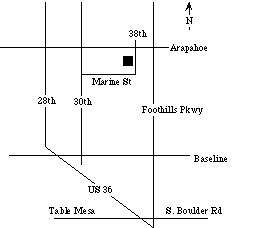The Cndnsd Vrsn: 4pm Tuesday July 22 ACS Rm 123 - Tom Cargill: Java's Remote Method Invocation (RMI) Model
Java's RMI is a mechanism that provides communication
between distributed Java Virtual Machines. The core
mechanism includes service registration, remote object
proxies, automatic parameter transmission for remote
method invocation, distributed garbage collection
and automatic client class loading. Many parts of
the core framework are designed to support a variety
of possible extensions. The talk will present the
core model, identifying its strengths and weaknesses.
See http://www.javasoft.com/products/jdk/1.1/docs/guide/rmi/index.html.
The next meeting of the Front Range UNIX Users Group will be in room 123 of the
CU Academic Computing Center building at Arapahoe and Marine Streets in Boulder.
Marine St intersects Arapahoe at 38th St; the Computing Center is on the southwest corner.

At the June 5th meeting of the Front Range UNIX Users Group
Rob Kolstad, president of Berkeley Software Design, Inc., gave a two-in-one talk on optimizing UNIX-based Web servers and E-mail servers for ultra-high throughput.
See the previous meetings page on the Fruug web site for more detail.
We have no plan for August yet, but stay tuned.
FRUUG is looking for users of the Apache WWW server on UNIX for a
possible Fall meeting on WWW server experience. If anyone is currently
running that server or knows anyone who is running it, please contact
wwedel at fruug.org
Contact the FRUUG Executive Committee at
fruug at fruug.org
if you have other interesting topic ideas or are interested in presenting a
fruug talk.
In the February FRUUG meeting Geoff Thompson presented the Java Event
Model. He had promised to answer the briefcase question but ran out of
time. Since then, inquiring minds have been bugging the FRUUG committee
demanding the answer. So here's Geoff's explanation.
The contents of the briefcase are never revealed. It's not explained in
the screenplay either. What we know is that people are willing to go to
extremes to get it and keep it, and that when the case is opened it gives
all a visible glow. (In both cases when it is opened, it is facing away
from the camera.) Also, people are very impressed by what they see when
they see it.
Did Quentin Tarantino, the director, screw up? Did he accidentally cut out
some line of dialog that explains it? No, the omission was intentional.
The contents of the briefcase is a "MacGuffin," a narrative device that
serves to move a story forward. In other movies it is the secret plans,
the microfilm, the computer disk, or magic formula. It really doesn't
matter what it is, only that characters in the story want it.
The MacGuffin is used by many film makers, but it was popularized by
Alfred Hitchcock who used it very effectively. In his interviews with
Francois Truffaut he describes how in his earlier movies he would have an
explanation of what exactly was the secret plan or vital formula and why
it was important. This explanation would come at the end of a movie, after
some exciting climatic action. Hitchcock found these scenes were tedious
and anti-climatic and later would make them as short as possible. In "Pulp
Fiction" Tarantino simply takes the MacGuffin to a logical extreme, he
eliminates the explanation all together. By adding the glow it makes all
the simple conjectures implausible (drugs, money, guns). It is
intentionally ambiguous and unexplained, leaving it to the imagination of
the viewers. It's more fun, it tweaks the viewer, it's more effective.
In interviews Tarantino never explained the contents. When John Travolta
was asked, he said it was two lights and a battery.
Now, what did all this have to do with Java. Tarantino was operating at a
higher level of abstraction. Providing a literal explanation would
trivialize it and make it less effective. Likewise, Java operates on a
virtual machine, a higher level of abstraction of a computing machine,
which is often more effective than the traditional machine dependent,
machine language approach.
Addison Wesley sent us a copy of Mark Sobell's new book,
A Practical Guide to Linux .
The USENIX Association sent us a copy of the proceedings
of the Third Conference on Object-Oriented Technologies and
Systems (COOTS), Portland, June 1997.
You may check books out using your business card as your library card; you
must be on the membership list to check books out. Books are due at the meeting
following the one in which they are checked out. If you don't
return your library books by the next meeting, you might find
yourself on our overdue book list.
We count on you returning books on time so that other members
may have the chance to use them as well.
Last Updated: 9 July 1997.
Problems? Contact
webmaster at fruug.org

|



